Marketing Strategies of Etihad Airways: A Detailed Analysis
VerifiedAdded on 2023/04/23
|30
|8500
|358
Report
AI Summary
This report provides a detailed analysis of the marketing management strategies employed by Etihad Airways in its global operations. It begins with an executive summary highlighting the airline's marketing orientation, customer-centric approach, and segmentation, targeting, and positioning (STP) strategies. The report delves into the specifics of Etihad's demographic, geographic, behavioral, and psychographic segmentation, followed by an examination of its differentiation and market focus targeting strategies. The positioning strategy, based on price and service features, is also discussed. Furthermore, the report conducts a SWOT analysis to evaluate Etihad's internal competencies, highlighting strengths, weaknesses, opportunities, and threats. PESTLE analysis is used to assess the external business environment, identifying political, economic, social, technological, legal, and environmental factors. Finally, the report utilizes the Ansoff matrix to determine strategic options for long-term business viability, recommending market development and market penetration strategies, including a new sub-brand for low-cost services. The report concludes with a summary of key findings and recommendations to ensure the airline's continued success.
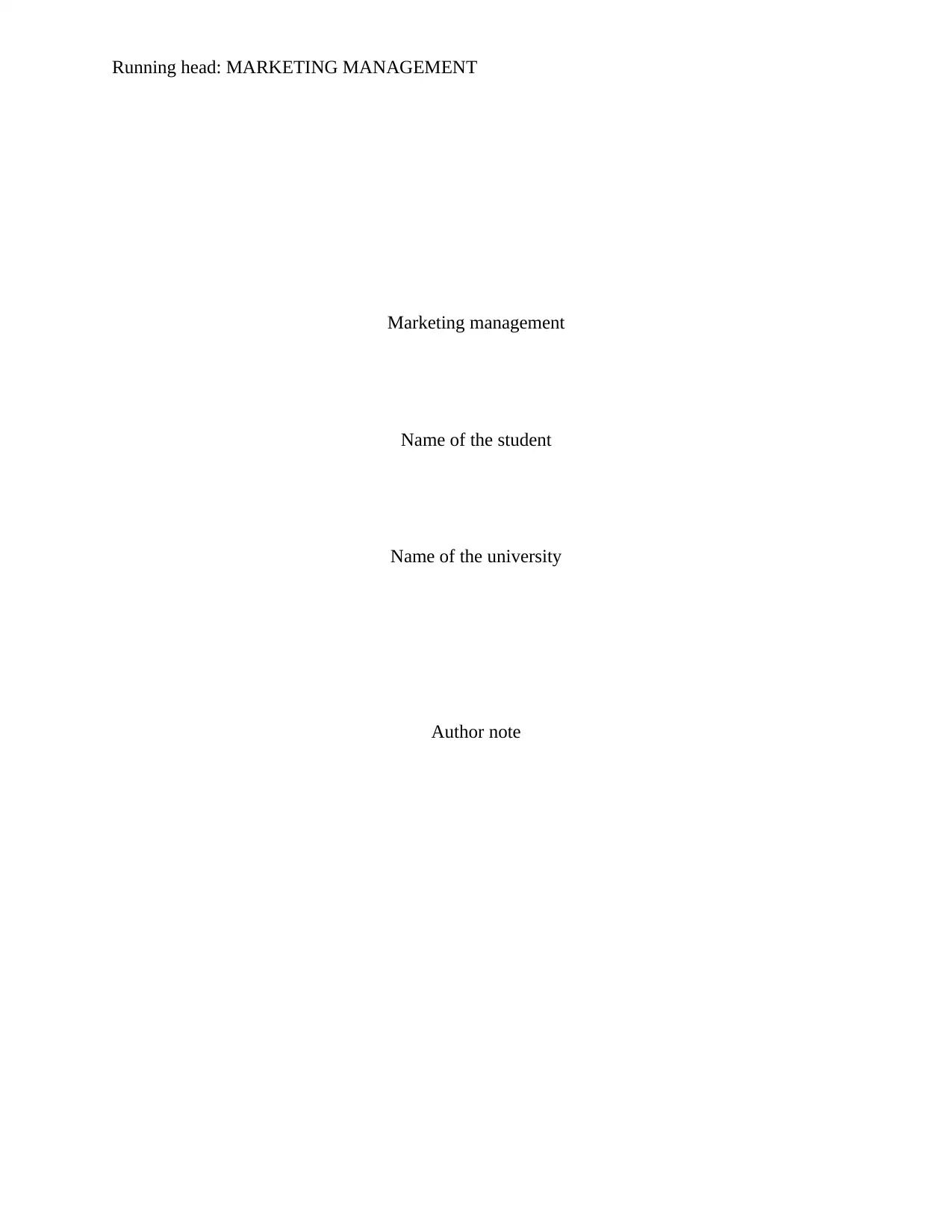
Running head: MARKETING MANAGEMENT
Marketing management
Name of the student
Name of the university
Author note
Marketing management
Name of the student
Name of the university
Author note
Paraphrase This Document
Need a fresh take? Get an instant paraphrase of this document with our AI Paraphraser
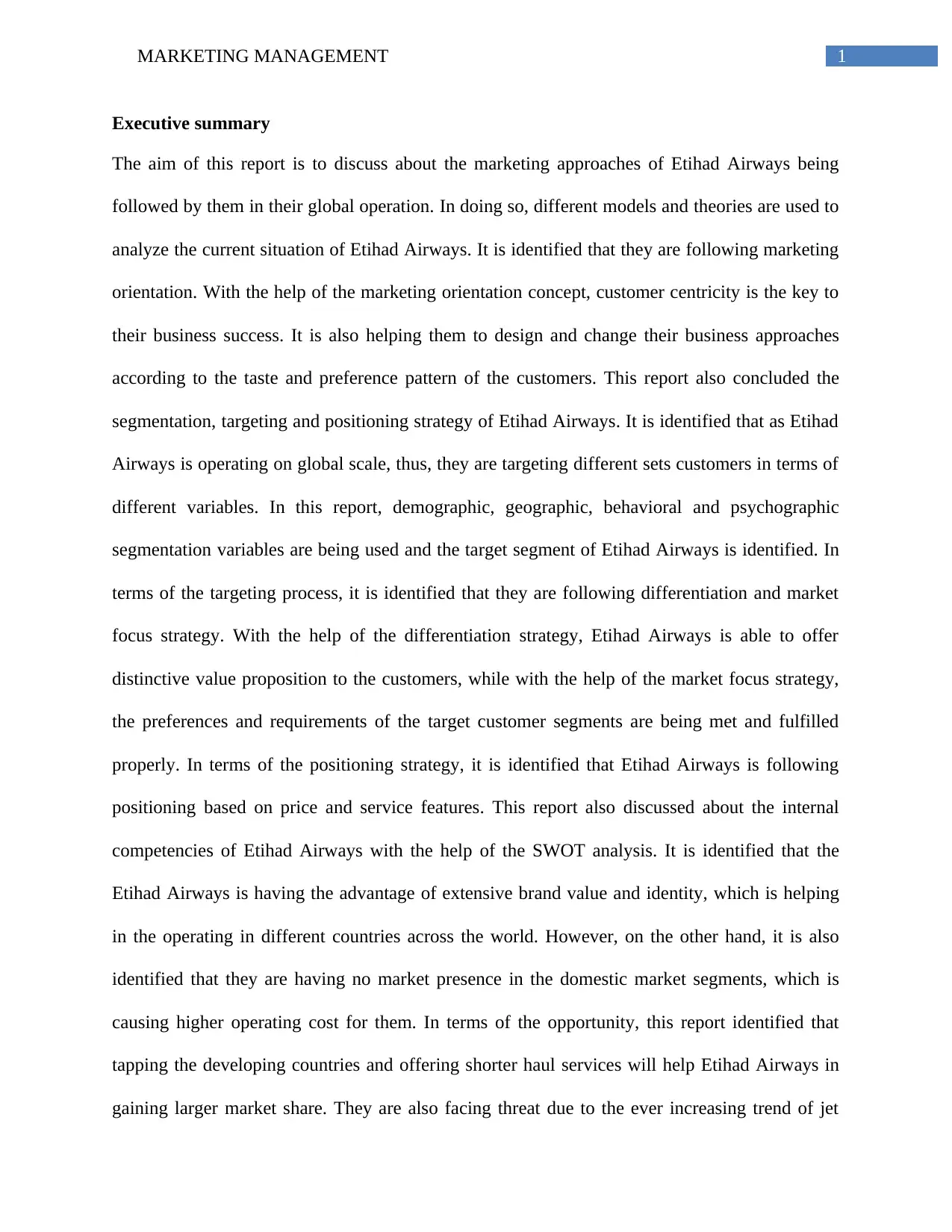
1MARKETING MANAGEMENT
Executive summary
The aim of this report is to discuss about the marketing approaches of Etihad Airways being
followed by them in their global operation. In doing so, different models and theories are used to
analyze the current situation of Etihad Airways. It is identified that they are following marketing
orientation. With the help of the marketing orientation concept, customer centricity is the key to
their business success. It is also helping them to design and change their business approaches
according to the taste and preference pattern of the customers. This report also concluded the
segmentation, targeting and positioning strategy of Etihad Airways. It is identified that as Etihad
Airways is operating on global scale, thus, they are targeting different sets customers in terms of
different variables. In this report, demographic, geographic, behavioral and psychographic
segmentation variables are being used and the target segment of Etihad Airways is identified. In
terms of the targeting process, it is identified that they are following differentiation and market
focus strategy. With the help of the differentiation strategy, Etihad Airways is able to offer
distinctive value proposition to the customers, while with the help of the market focus strategy,
the preferences and requirements of the target customer segments are being met and fulfilled
properly. In terms of the positioning strategy, it is identified that Etihad Airways is following
positioning based on price and service features. This report also discussed about the internal
competencies of Etihad Airways with the help of the SWOT analysis. It is identified that the
Etihad Airways is having the advantage of extensive brand value and identity, which is helping
in the operating in different countries across the world. However, on the other hand, it is also
identified that they are having no market presence in the domestic market segments, which is
causing higher operating cost for them. In terms of the opportunity, this report identified that
tapping the developing countries and offering shorter haul services will help Etihad Airways in
gaining larger market share. They are also facing threat due to the ever increasing trend of jet
Executive summary
The aim of this report is to discuss about the marketing approaches of Etihad Airways being
followed by them in their global operation. In doing so, different models and theories are used to
analyze the current situation of Etihad Airways. It is identified that they are following marketing
orientation. With the help of the marketing orientation concept, customer centricity is the key to
their business success. It is also helping them to design and change their business approaches
according to the taste and preference pattern of the customers. This report also concluded the
segmentation, targeting and positioning strategy of Etihad Airways. It is identified that as Etihad
Airways is operating on global scale, thus, they are targeting different sets customers in terms of
different variables. In this report, demographic, geographic, behavioral and psychographic
segmentation variables are being used and the target segment of Etihad Airways is identified. In
terms of the targeting process, it is identified that they are following differentiation and market
focus strategy. With the help of the differentiation strategy, Etihad Airways is able to offer
distinctive value proposition to the customers, while with the help of the market focus strategy,
the preferences and requirements of the target customer segments are being met and fulfilled
properly. In terms of the positioning strategy, it is identified that Etihad Airways is following
positioning based on price and service features. This report also discussed about the internal
competencies of Etihad Airways with the help of the SWOT analysis. It is identified that the
Etihad Airways is having the advantage of extensive brand value and identity, which is helping
in the operating in different countries across the world. However, on the other hand, it is also
identified that they are having no market presence in the domestic market segments, which is
causing higher operating cost for them. In terms of the opportunity, this report identified that
tapping the developing countries and offering shorter haul services will help Etihad Airways in
gaining larger market share. They are also facing threat due to the ever increasing trend of jet
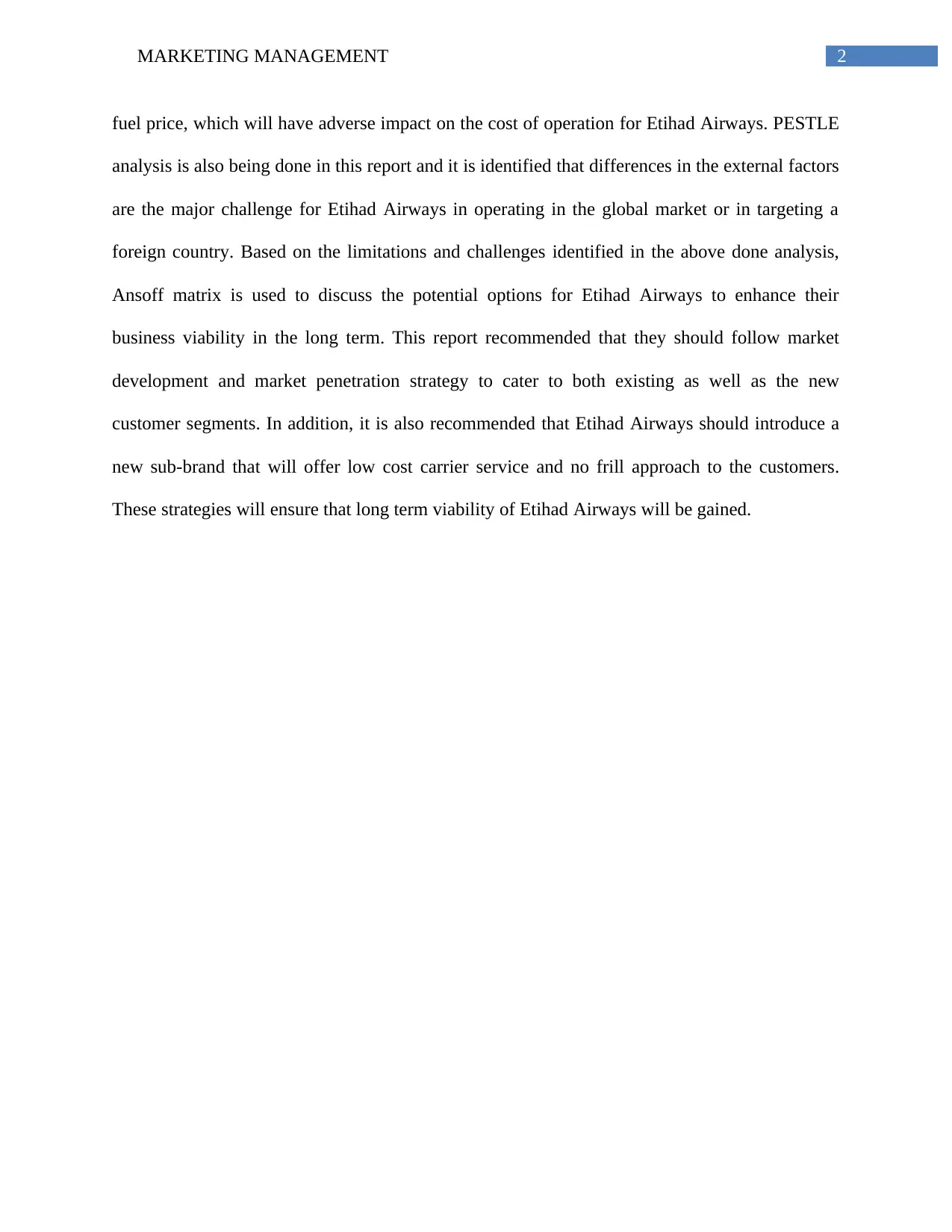
2MARKETING MANAGEMENT
fuel price, which will have adverse impact on the cost of operation for Etihad Airways. PESTLE
analysis is also being done in this report and it is identified that differences in the external factors
are the major challenge for Etihad Airways in operating in the global market or in targeting a
foreign country. Based on the limitations and challenges identified in the above done analysis,
Ansoff matrix is used to discuss the potential options for Etihad Airways to enhance their
business viability in the long term. This report recommended that they should follow market
development and market penetration strategy to cater to both existing as well as the new
customer segments. In addition, it is also recommended that Etihad Airways should introduce a
new sub-brand that will offer low cost carrier service and no frill approach to the customers.
These strategies will ensure that long term viability of Etihad Airways will be gained.
fuel price, which will have adverse impact on the cost of operation for Etihad Airways. PESTLE
analysis is also being done in this report and it is identified that differences in the external factors
are the major challenge for Etihad Airways in operating in the global market or in targeting a
foreign country. Based on the limitations and challenges identified in the above done analysis,
Ansoff matrix is used to discuss the potential options for Etihad Airways to enhance their
business viability in the long term. This report recommended that they should follow market
development and market penetration strategy to cater to both existing as well as the new
customer segments. In addition, it is also recommended that Etihad Airways should introduce a
new sub-brand that will offer low cost carrier service and no frill approach to the customers.
These strategies will ensure that long term viability of Etihad Airways will be gained.
⊘ This is a preview!⊘
Do you want full access?
Subscribe today to unlock all pages.

Trusted by 1+ million students worldwide
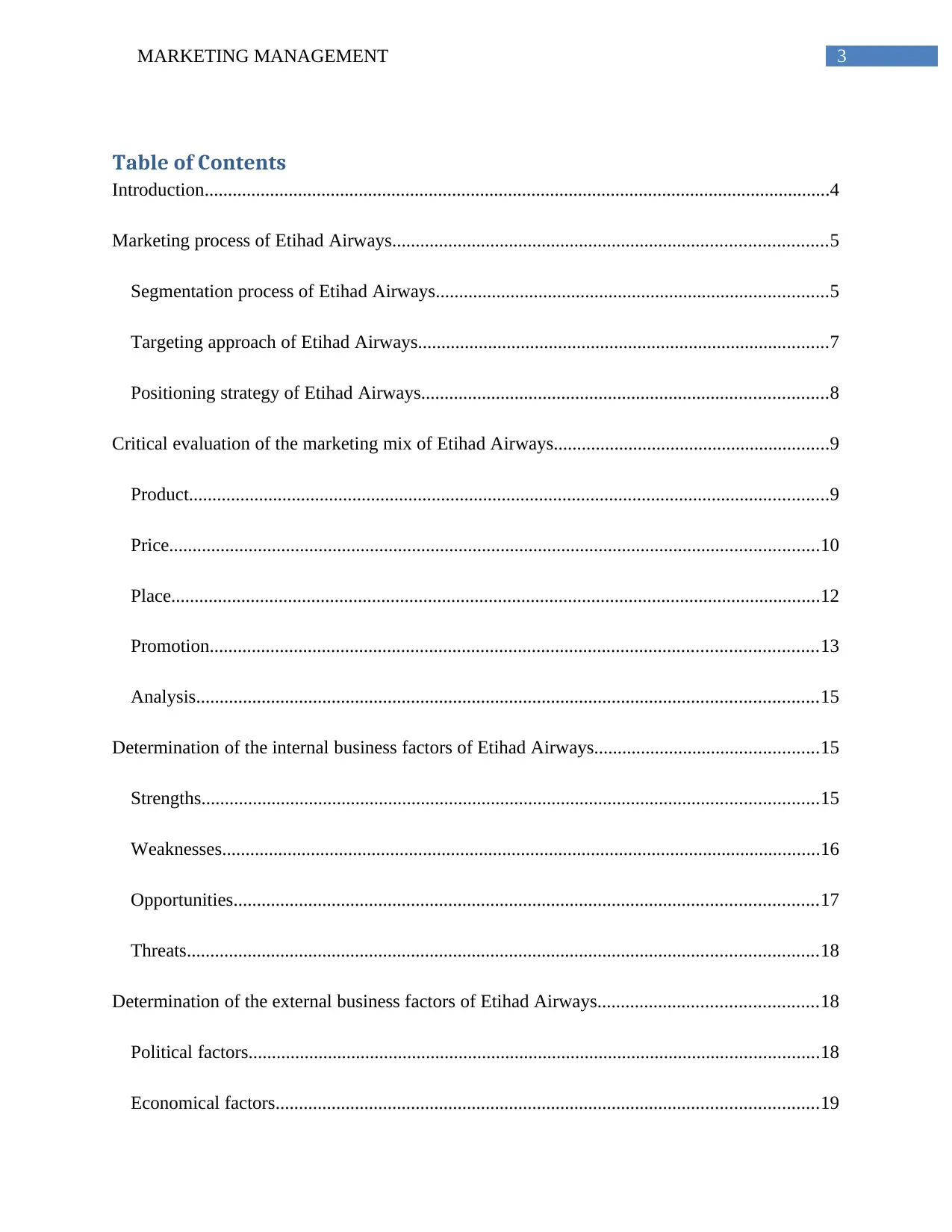
3MARKETING MANAGEMENT
Table of Contents
Introduction......................................................................................................................................4
Marketing process of Etihad Airways.............................................................................................5
Segmentation process of Etihad Airways....................................................................................5
Targeting approach of Etihad Airways........................................................................................7
Positioning strategy of Etihad Airways.......................................................................................8
Critical evaluation of the marketing mix of Etihad Airways...........................................................9
Product.........................................................................................................................................9
Price...........................................................................................................................................10
Place...........................................................................................................................................12
Promotion..................................................................................................................................13
Analysis.....................................................................................................................................15
Determination of the internal business factors of Etihad Airways................................................15
Strengths....................................................................................................................................15
Weaknesses................................................................................................................................16
Opportunities.............................................................................................................................17
Threats.......................................................................................................................................18
Determination of the external business factors of Etihad Airways...............................................18
Political factors..........................................................................................................................18
Economical factors....................................................................................................................19
Table of Contents
Introduction......................................................................................................................................4
Marketing process of Etihad Airways.............................................................................................5
Segmentation process of Etihad Airways....................................................................................5
Targeting approach of Etihad Airways........................................................................................7
Positioning strategy of Etihad Airways.......................................................................................8
Critical evaluation of the marketing mix of Etihad Airways...........................................................9
Product.........................................................................................................................................9
Price...........................................................................................................................................10
Place...........................................................................................................................................12
Promotion..................................................................................................................................13
Analysis.....................................................................................................................................15
Determination of the internal business factors of Etihad Airways................................................15
Strengths....................................................................................................................................15
Weaknesses................................................................................................................................16
Opportunities.............................................................................................................................17
Threats.......................................................................................................................................18
Determination of the external business factors of Etihad Airways...............................................18
Political factors..........................................................................................................................18
Economical factors....................................................................................................................19
Paraphrase This Document
Need a fresh take? Get an instant paraphrase of this document with our AI Paraphraser
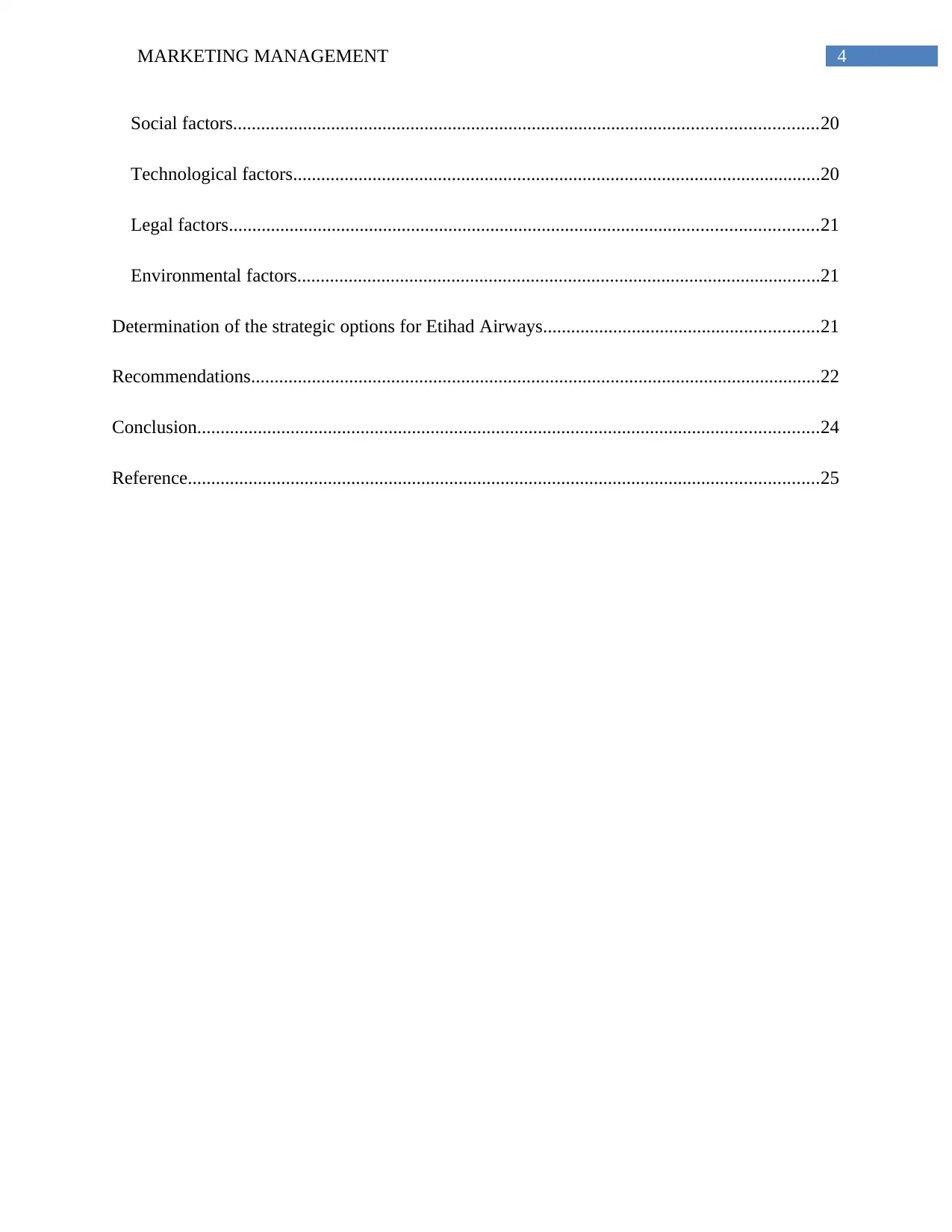
4MARKETING MANAGEMENT
Social factors.............................................................................................................................20
Technological factors.................................................................................................................20
Legal factors..............................................................................................................................21
Environmental factors................................................................................................................21
Determination of the strategic options for Etihad Airways...........................................................21
Recommendations..........................................................................................................................22
Conclusion.....................................................................................................................................24
Reference.......................................................................................................................................25
Social factors.............................................................................................................................20
Technological factors.................................................................................................................20
Legal factors..............................................................................................................................21
Environmental factors................................................................................................................21
Determination of the strategic options for Etihad Airways...........................................................21
Recommendations..........................................................................................................................22
Conclusion.....................................................................................................................................24
Reference.......................................................................................................................................25
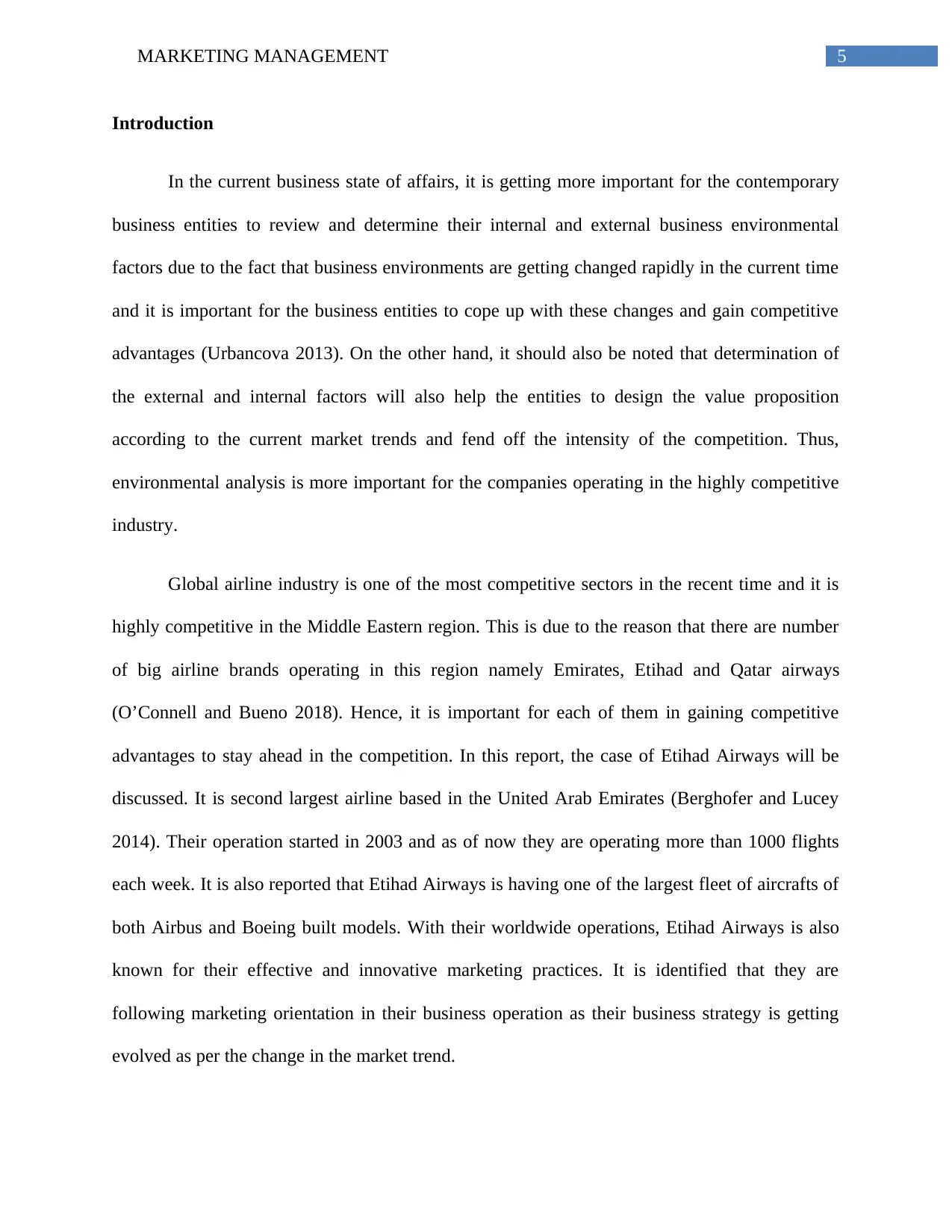
5MARKETING MANAGEMENT
Introduction
In the current business state of affairs, it is getting more important for the contemporary
business entities to review and determine their internal and external business environmental
factors due to the fact that business environments are getting changed rapidly in the current time
and it is important for the business entities to cope up with these changes and gain competitive
advantages (Urbancova 2013). On the other hand, it should also be noted that determination of
the external and internal factors will also help the entities to design the value proposition
according to the current market trends and fend off the intensity of the competition. Thus,
environmental analysis is more important for the companies operating in the highly competitive
industry.
Global airline industry is one of the most competitive sectors in the recent time and it is
highly competitive in the Middle Eastern region. This is due to the reason that there are number
of big airline brands operating in this region namely Emirates, Etihad and Qatar airways
(O’Connell and Bueno 2018). Hence, it is important for each of them in gaining competitive
advantages to stay ahead in the competition. In this report, the case of Etihad Airways will be
discussed. It is second largest airline based in the United Arab Emirates (Berghofer and Lucey
2014). Their operation started in 2003 and as of now they are operating more than 1000 flights
each week. It is also reported that Etihad Airways is having one of the largest fleet of aircrafts of
both Airbus and Boeing built models. With their worldwide operations, Etihad Airways is also
known for their effective and innovative marketing practices. It is identified that they are
following marketing orientation in their business operation as their business strategy is getting
evolved as per the change in the market trend.
Introduction
In the current business state of affairs, it is getting more important for the contemporary
business entities to review and determine their internal and external business environmental
factors due to the fact that business environments are getting changed rapidly in the current time
and it is important for the business entities to cope up with these changes and gain competitive
advantages (Urbancova 2013). On the other hand, it should also be noted that determination of
the external and internal factors will also help the entities to design the value proposition
according to the current market trends and fend off the intensity of the competition. Thus,
environmental analysis is more important for the companies operating in the highly competitive
industry.
Global airline industry is one of the most competitive sectors in the recent time and it is
highly competitive in the Middle Eastern region. This is due to the reason that there are number
of big airline brands operating in this region namely Emirates, Etihad and Qatar airways
(O’Connell and Bueno 2018). Hence, it is important for each of them in gaining competitive
advantages to stay ahead in the competition. In this report, the case of Etihad Airways will be
discussed. It is second largest airline based in the United Arab Emirates (Berghofer and Lucey
2014). Their operation started in 2003 and as of now they are operating more than 1000 flights
each week. It is also reported that Etihad Airways is having one of the largest fleet of aircrafts of
both Airbus and Boeing built models. With their worldwide operations, Etihad Airways is also
known for their effective and innovative marketing practices. It is identified that they are
following marketing orientation in their business operation as their business strategy is getting
evolved as per the change in the market trend.
⊘ This is a preview!⊘
Do you want full access?
Subscribe today to unlock all pages.

Trusted by 1+ million students worldwide
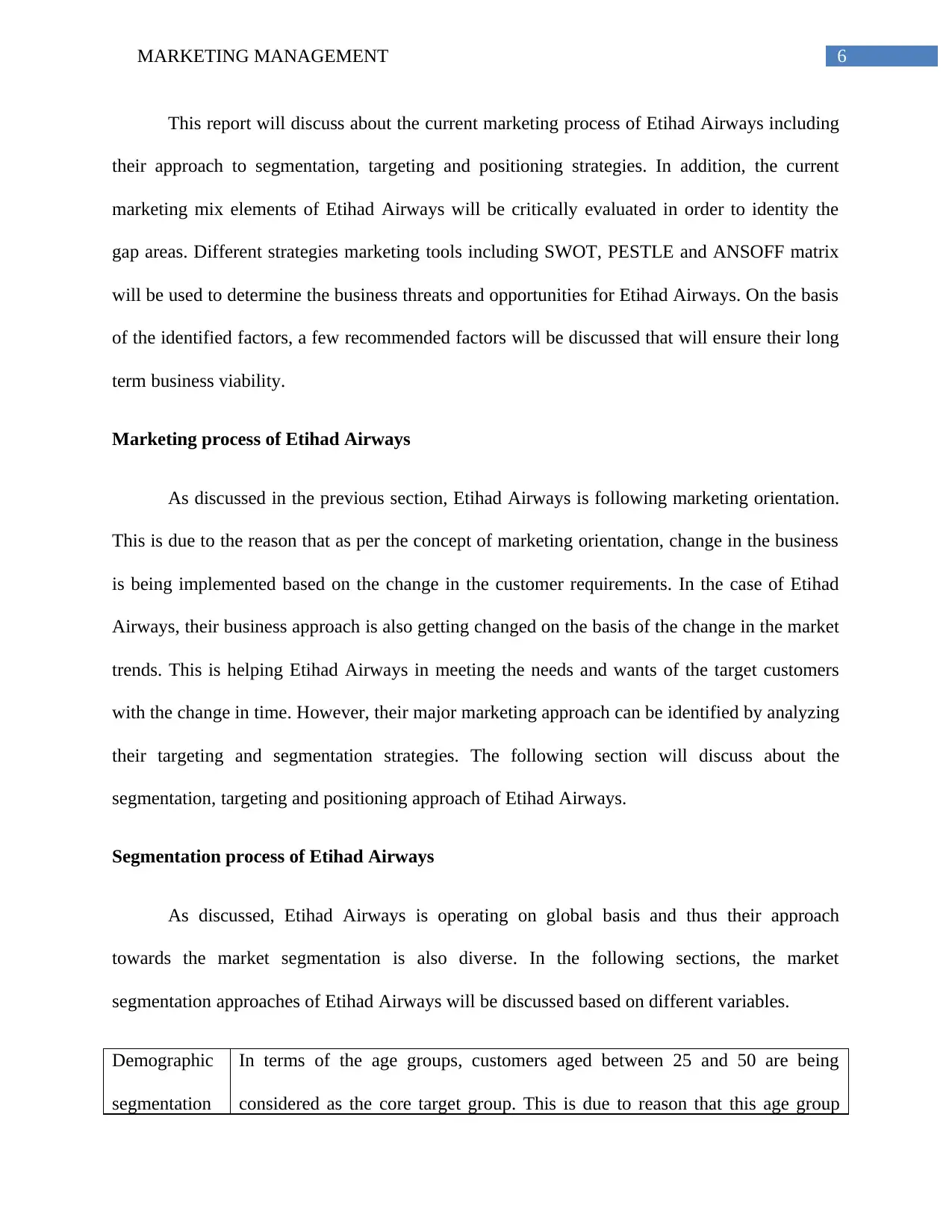
6MARKETING MANAGEMENT
This report will discuss about the current marketing process of Etihad Airways including
their approach to segmentation, targeting and positioning strategies. In addition, the current
marketing mix elements of Etihad Airways will be critically evaluated in order to identity the
gap areas. Different strategies marketing tools including SWOT, PESTLE and ANSOFF matrix
will be used to determine the business threats and opportunities for Etihad Airways. On the basis
of the identified factors, a few recommended factors will be discussed that will ensure their long
term business viability.
Marketing process of Etihad Airways
As discussed in the previous section, Etihad Airways is following marketing orientation.
This is due to the reason that as per the concept of marketing orientation, change in the business
is being implemented based on the change in the customer requirements. In the case of Etihad
Airways, their business approach is also getting changed on the basis of the change in the market
trends. This is helping Etihad Airways in meeting the needs and wants of the target customers
with the change in time. However, their major marketing approach can be identified by analyzing
their targeting and segmentation strategies. The following section will discuss about the
segmentation, targeting and positioning approach of Etihad Airways.
Segmentation process of Etihad Airways
As discussed, Etihad Airways is operating on global basis and thus their approach
towards the market segmentation is also diverse. In the following sections, the market
segmentation approaches of Etihad Airways will be discussed based on different variables.
Demographic
segmentation
In terms of the age groups, customers aged between 25 and 50 are being
considered as the core target group. This is due to reason that this age group
This report will discuss about the current marketing process of Etihad Airways including
their approach to segmentation, targeting and positioning strategies. In addition, the current
marketing mix elements of Etihad Airways will be critically evaluated in order to identity the
gap areas. Different strategies marketing tools including SWOT, PESTLE and ANSOFF matrix
will be used to determine the business threats and opportunities for Etihad Airways. On the basis
of the identified factors, a few recommended factors will be discussed that will ensure their long
term business viability.
Marketing process of Etihad Airways
As discussed in the previous section, Etihad Airways is following marketing orientation.
This is due to the reason that as per the concept of marketing orientation, change in the business
is being implemented based on the change in the customer requirements. In the case of Etihad
Airways, their business approach is also getting changed on the basis of the change in the market
trends. This is helping Etihad Airways in meeting the needs and wants of the target customers
with the change in time. However, their major marketing approach can be identified by analyzing
their targeting and segmentation strategies. The following section will discuss about the
segmentation, targeting and positioning approach of Etihad Airways.
Segmentation process of Etihad Airways
As discussed, Etihad Airways is operating on global basis and thus their approach
towards the market segmentation is also diverse. In the following sections, the market
segmentation approaches of Etihad Airways will be discussed based on different variables.
Demographic
segmentation
In terms of the age groups, customers aged between 25 and 50 are being
considered as the core target group. This is due to reason that this age group
Paraphrase This Document
Need a fresh take? Get an instant paraphrase of this document with our AI Paraphraser
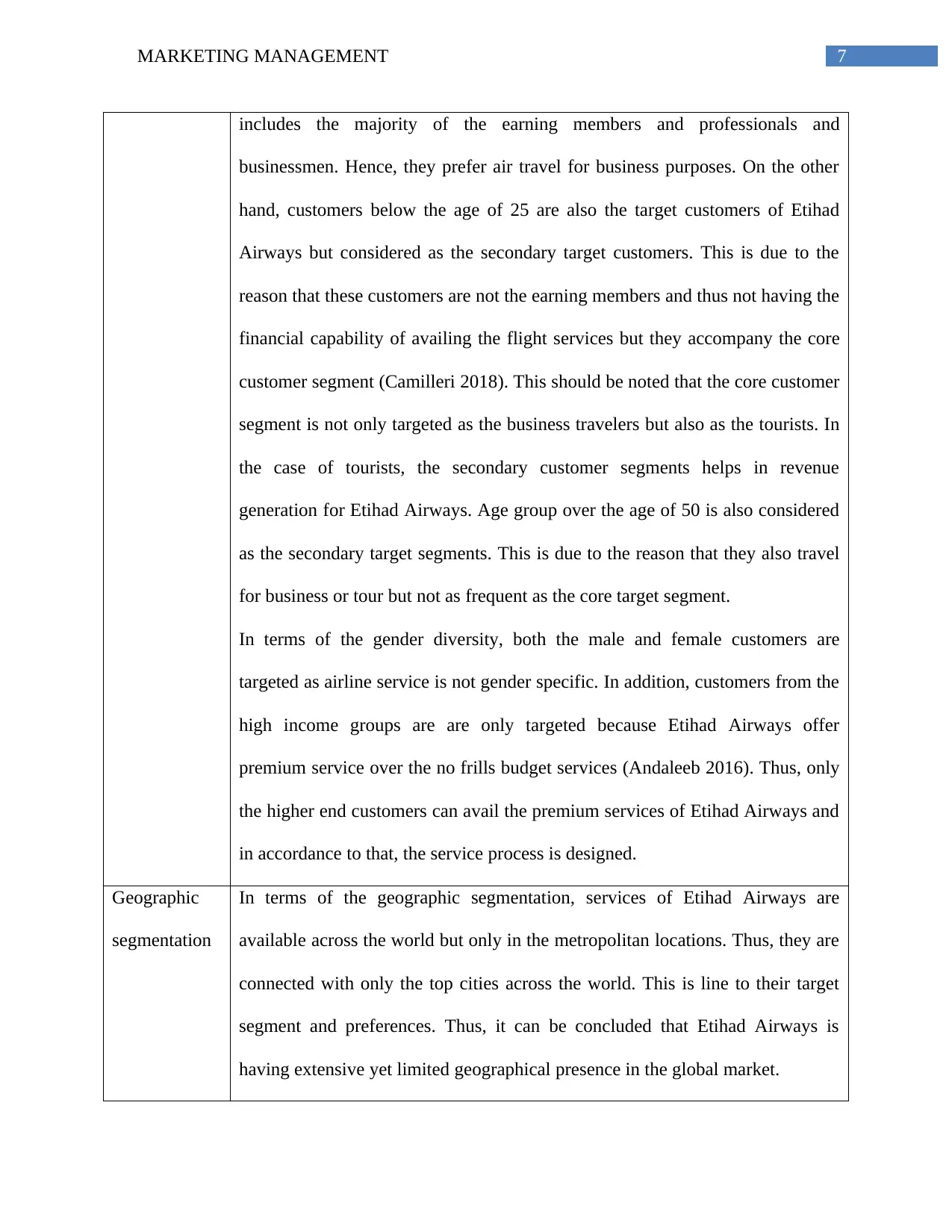
7MARKETING MANAGEMENT
includes the majority of the earning members and professionals and
businessmen. Hence, they prefer air travel for business purposes. On the other
hand, customers below the age of 25 are also the target customers of Etihad
Airways but considered as the secondary target customers. This is due to the
reason that these customers are not the earning members and thus not having the
financial capability of availing the flight services but they accompany the core
customer segment (Camilleri 2018). This should be noted that the core customer
segment is not only targeted as the business travelers but also as the tourists. In
the case of tourists, the secondary customer segments helps in revenue
generation for Etihad Airways. Age group over the age of 50 is also considered
as the secondary target segments. This is due to the reason that they also travel
for business or tour but not as frequent as the core target segment.
In terms of the gender diversity, both the male and female customers are
targeted as airline service is not gender specific. In addition, customers from the
high income groups are are only targeted because Etihad Airways offer
premium service over the no frills budget services (Andaleeb 2016). Thus, only
the higher end customers can avail the premium services of Etihad Airways and
in accordance to that, the service process is designed.
Geographic
segmentation
In terms of the geographic segmentation, services of Etihad Airways are
available across the world but only in the metropolitan locations. Thus, they are
connected with only the top cities across the world. This is line to their target
segment and preferences. Thus, it can be concluded that Etihad Airways is
having extensive yet limited geographical presence in the global market.
includes the majority of the earning members and professionals and
businessmen. Hence, they prefer air travel for business purposes. On the other
hand, customers below the age of 25 are also the target customers of Etihad
Airways but considered as the secondary target customers. This is due to the
reason that these customers are not the earning members and thus not having the
financial capability of availing the flight services but they accompany the core
customer segment (Camilleri 2018). This should be noted that the core customer
segment is not only targeted as the business travelers but also as the tourists. In
the case of tourists, the secondary customer segments helps in revenue
generation for Etihad Airways. Age group over the age of 50 is also considered
as the secondary target segments. This is due to the reason that they also travel
for business or tour but not as frequent as the core target segment.
In terms of the gender diversity, both the male and female customers are
targeted as airline service is not gender specific. In addition, customers from the
high income groups are are only targeted because Etihad Airways offer
premium service over the no frills budget services (Andaleeb 2016). Thus, only
the higher end customers can avail the premium services of Etihad Airways and
in accordance to that, the service process is designed.
Geographic
segmentation
In terms of the geographic segmentation, services of Etihad Airways are
available across the world but only in the metropolitan locations. Thus, they are
connected with only the top cities across the world. This is line to their target
segment and preferences. Thus, it can be concluded that Etihad Airways is
having extensive yet limited geographical presence in the global market.
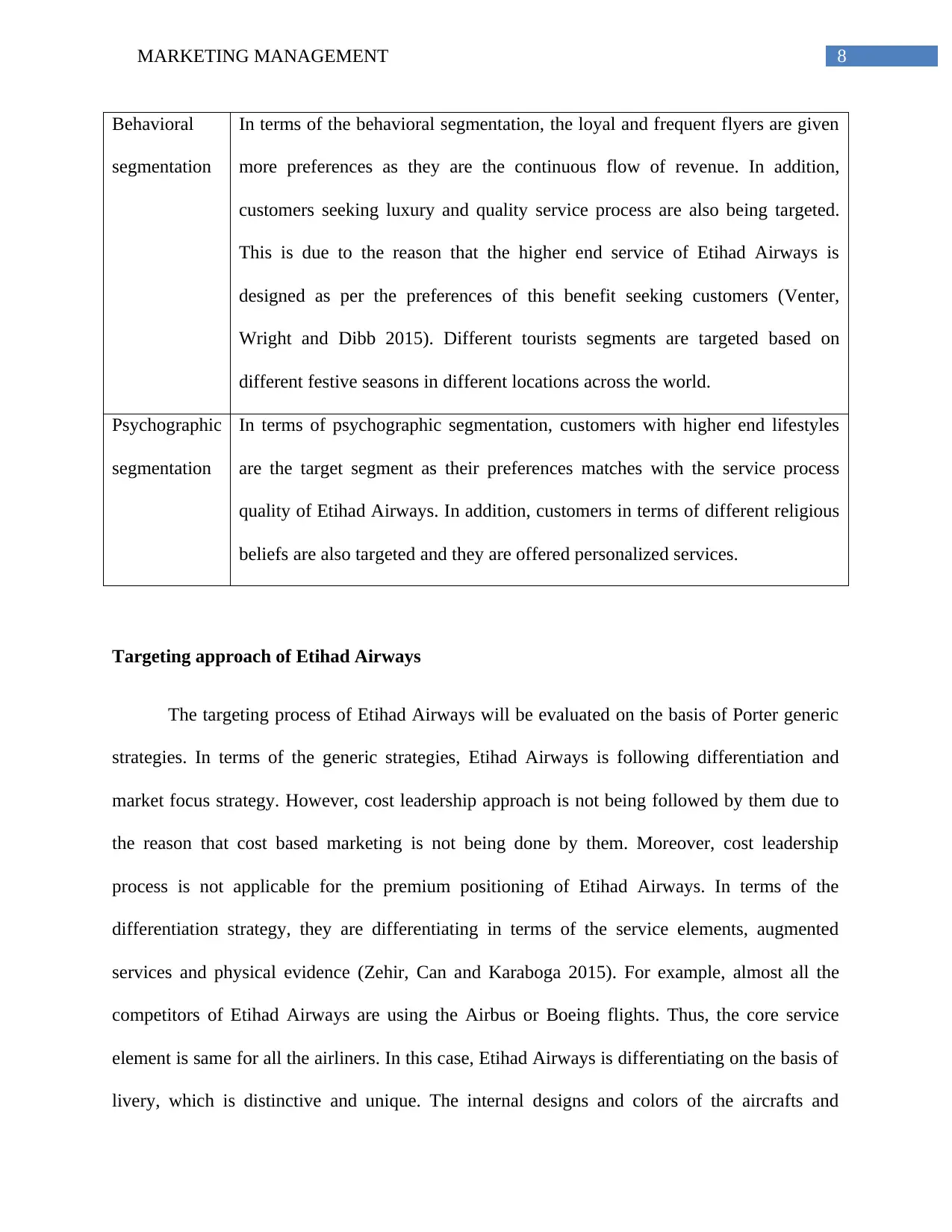
8MARKETING MANAGEMENT
Behavioral
segmentation
In terms of the behavioral segmentation, the loyal and frequent flyers are given
more preferences as they are the continuous flow of revenue. In addition,
customers seeking luxury and quality service process are also being targeted.
This is due to the reason that the higher end service of Etihad Airways is
designed as per the preferences of this benefit seeking customers (Venter,
Wright and Dibb 2015). Different tourists segments are targeted based on
different festive seasons in different locations across the world.
Psychographic
segmentation
In terms of psychographic segmentation, customers with higher end lifestyles
are the target segment as their preferences matches with the service process
quality of Etihad Airways. In addition, customers in terms of different religious
beliefs are also targeted and they are offered personalized services.
Targeting approach of Etihad Airways
The targeting process of Etihad Airways will be evaluated on the basis of Porter generic
strategies. In terms of the generic strategies, Etihad Airways is following differentiation and
market focus strategy. However, cost leadership approach is not being followed by them due to
the reason that cost based marketing is not being done by them. Moreover, cost leadership
process is not applicable for the premium positioning of Etihad Airways. In terms of the
differentiation strategy, they are differentiating in terms of the service elements, augmented
services and physical evidence (Zehir, Can and Karaboga 2015). For example, almost all the
competitors of Etihad Airways are using the Airbus or Boeing flights. Thus, the core service
element is same for all the airliners. In this case, Etihad Airways is differentiating on the basis of
livery, which is distinctive and unique. The internal designs and colors of the aircrafts and
Behavioral
segmentation
In terms of the behavioral segmentation, the loyal and frequent flyers are given
more preferences as they are the continuous flow of revenue. In addition,
customers seeking luxury and quality service process are also being targeted.
This is due to the reason that the higher end service of Etihad Airways is
designed as per the preferences of this benefit seeking customers (Venter,
Wright and Dibb 2015). Different tourists segments are targeted based on
different festive seasons in different locations across the world.
Psychographic
segmentation
In terms of psychographic segmentation, customers with higher end lifestyles
are the target segment as their preferences matches with the service process
quality of Etihad Airways. In addition, customers in terms of different religious
beliefs are also targeted and they are offered personalized services.
Targeting approach of Etihad Airways
The targeting process of Etihad Airways will be evaluated on the basis of Porter generic
strategies. In terms of the generic strategies, Etihad Airways is following differentiation and
market focus strategy. However, cost leadership approach is not being followed by them due to
the reason that cost based marketing is not being done by them. Moreover, cost leadership
process is not applicable for the premium positioning of Etihad Airways. In terms of the
differentiation strategy, they are differentiating in terms of the service elements, augmented
services and physical evidence (Zehir, Can and Karaboga 2015). For example, almost all the
competitors of Etihad Airways are using the Airbus or Boeing flights. Thus, the core service
element is same for all the airliners. In this case, Etihad Airways is differentiating on the basis of
livery, which is distinctive and unique. The internal designs and colors of the aircrafts and
⊘ This is a preview!⊘
Do you want full access?
Subscribe today to unlock all pages.

Trusted by 1+ million students worldwide
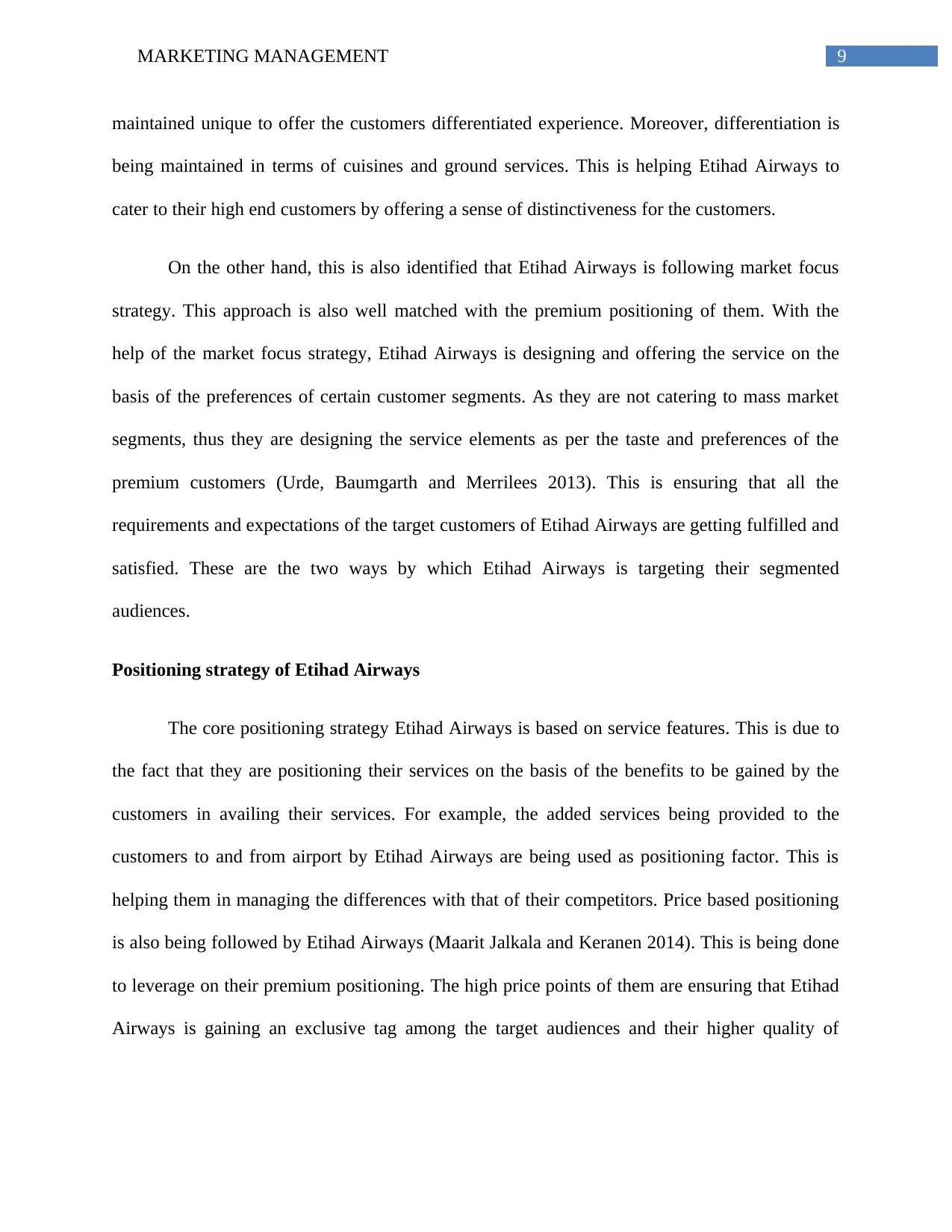
9MARKETING MANAGEMENT
maintained unique to offer the customers differentiated experience. Moreover, differentiation is
being maintained in terms of cuisines and ground services. This is helping Etihad Airways to
cater to their high end customers by offering a sense of distinctiveness for the customers.
On the other hand, this is also identified that Etihad Airways is following market focus
strategy. This approach is also well matched with the premium positioning of them. With the
help of the market focus strategy, Etihad Airways is designing and offering the service on the
basis of the preferences of certain customer segments. As they are not catering to mass market
segments, thus they are designing the service elements as per the taste and preferences of the
premium customers (Urde, Baumgarth and Merrilees 2013). This is ensuring that all the
requirements and expectations of the target customers of Etihad Airways are getting fulfilled and
satisfied. These are the two ways by which Etihad Airways is targeting their segmented
audiences.
Positioning strategy of Etihad Airways
The core positioning strategy Etihad Airways is based on service features. This is due to
the fact that they are positioning their services on the basis of the benefits to be gained by the
customers in availing their services. For example, the added services being provided to the
customers to and from airport by Etihad Airways are being used as positioning factor. This is
helping them in managing the differences with that of their competitors. Price based positioning
is also being followed by Etihad Airways (Maarit Jalkala and Keranen 2014). This is being done
to leverage on their premium positioning. The high price points of them are ensuring that Etihad
Airways is gaining an exclusive tag among the target audiences and their higher quality of
maintained unique to offer the customers differentiated experience. Moreover, differentiation is
being maintained in terms of cuisines and ground services. This is helping Etihad Airways to
cater to their high end customers by offering a sense of distinctiveness for the customers.
On the other hand, this is also identified that Etihad Airways is following market focus
strategy. This approach is also well matched with the premium positioning of them. With the
help of the market focus strategy, Etihad Airways is designing and offering the service on the
basis of the preferences of certain customer segments. As they are not catering to mass market
segments, thus they are designing the service elements as per the taste and preferences of the
premium customers (Urde, Baumgarth and Merrilees 2013). This is ensuring that all the
requirements and expectations of the target customers of Etihad Airways are getting fulfilled and
satisfied. These are the two ways by which Etihad Airways is targeting their segmented
audiences.
Positioning strategy of Etihad Airways
The core positioning strategy Etihad Airways is based on service features. This is due to
the fact that they are positioning their services on the basis of the benefits to be gained by the
customers in availing their services. For example, the added services being provided to the
customers to and from airport by Etihad Airways are being used as positioning factor. This is
helping them in managing the differences with that of their competitors. Price based positioning
is also being followed by Etihad Airways (Maarit Jalkala and Keranen 2014). This is being done
to leverage on their premium positioning. The high price points of them are ensuring that Etihad
Airways is gaining an exclusive tag among the target audiences and their higher quality of
Paraphrase This Document
Need a fresh take? Get an instant paraphrase of this document with our AI Paraphraser
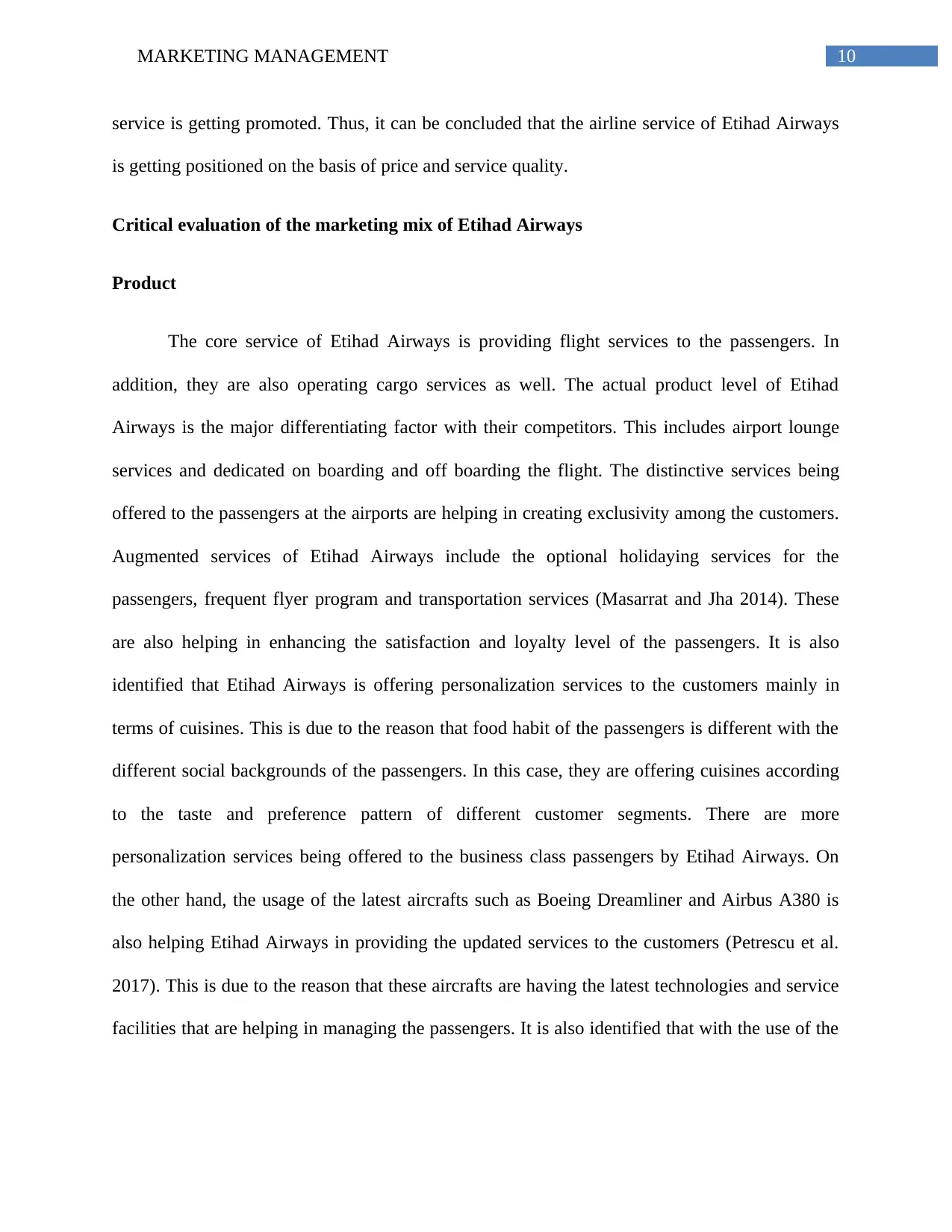
10MARKETING MANAGEMENT
service is getting promoted. Thus, it can be concluded that the airline service of Etihad Airways
is getting positioned on the basis of price and service quality.
Critical evaluation of the marketing mix of Etihad Airways
Product
The core service of Etihad Airways is providing flight services to the passengers. In
addition, they are also operating cargo services as well. The actual product level of Etihad
Airways is the major differentiating factor with their competitors. This includes airport lounge
services and dedicated on boarding and off boarding the flight. The distinctive services being
offered to the passengers at the airports are helping in creating exclusivity among the customers.
Augmented services of Etihad Airways include the optional holidaying services for the
passengers, frequent flyer program and transportation services (Masarrat and Jha 2014). These
are also helping in enhancing the satisfaction and loyalty level of the passengers. It is also
identified that Etihad Airways is offering personalization services to the customers mainly in
terms of cuisines. This is due to the reason that food habit of the passengers is different with the
different social backgrounds of the passengers. In this case, they are offering cuisines according
to the taste and preference pattern of different customer segments. There are more
personalization services being offered to the business class passengers by Etihad Airways. On
the other hand, the usage of the latest aircrafts such as Boeing Dreamliner and Airbus A380 is
also helping Etihad Airways in providing the updated services to the customers (Petrescu et al.
2017). This is due to the reason that these aircrafts are having the latest technologies and service
facilities that are helping in managing the passengers. It is also identified that with the use of the
service is getting promoted. Thus, it can be concluded that the airline service of Etihad Airways
is getting positioned on the basis of price and service quality.
Critical evaluation of the marketing mix of Etihad Airways
Product
The core service of Etihad Airways is providing flight services to the passengers. In
addition, they are also operating cargo services as well. The actual product level of Etihad
Airways is the major differentiating factor with their competitors. This includes airport lounge
services and dedicated on boarding and off boarding the flight. The distinctive services being
offered to the passengers at the airports are helping in creating exclusivity among the customers.
Augmented services of Etihad Airways include the optional holidaying services for the
passengers, frequent flyer program and transportation services (Masarrat and Jha 2014). These
are also helping in enhancing the satisfaction and loyalty level of the passengers. It is also
identified that Etihad Airways is offering personalization services to the customers mainly in
terms of cuisines. This is due to the reason that food habit of the passengers is different with the
different social backgrounds of the passengers. In this case, they are offering cuisines according
to the taste and preference pattern of different customer segments. There are more
personalization services being offered to the business class passengers by Etihad Airways. On
the other hand, the usage of the latest aircrafts such as Boeing Dreamliner and Airbus A380 is
also helping Etihad Airways in providing the updated services to the customers (Petrescu et al.
2017). This is due to the reason that these aircrafts are having the latest technologies and service
facilities that are helping in managing the passengers. It is also identified that with the use of the
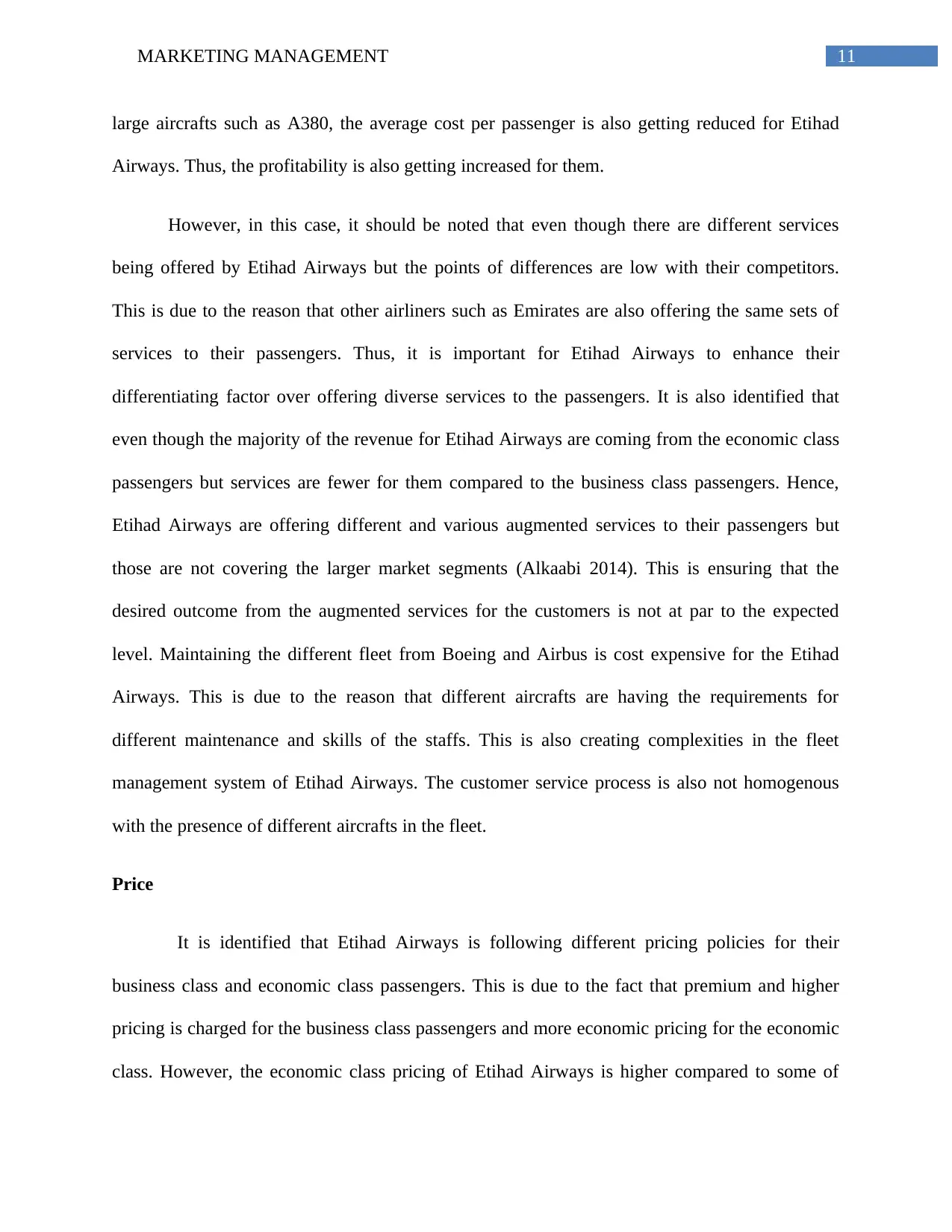
11MARKETING MANAGEMENT
large aircrafts such as A380, the average cost per passenger is also getting reduced for Etihad
Airways. Thus, the profitability is also getting increased for them.
However, in this case, it should be noted that even though there are different services
being offered by Etihad Airways but the points of differences are low with their competitors.
This is due to the reason that other airliners such as Emirates are also offering the same sets of
services to their passengers. Thus, it is important for Etihad Airways to enhance their
differentiating factor over offering diverse services to the passengers. It is also identified that
even though the majority of the revenue for Etihad Airways are coming from the economic class
passengers but services are fewer for them compared to the business class passengers. Hence,
Etihad Airways are offering different and various augmented services to their passengers but
those are not covering the larger market segments (Alkaabi 2014). This is ensuring that the
desired outcome from the augmented services for the customers is not at par to the expected
level. Maintaining the different fleet from Boeing and Airbus is cost expensive for the Etihad
Airways. This is due to the reason that different aircrafts are having the requirements for
different maintenance and skills of the staffs. This is also creating complexities in the fleet
management system of Etihad Airways. The customer service process is also not homogenous
with the presence of different aircrafts in the fleet.
Price
It is identified that Etihad Airways is following different pricing policies for their
business class and economic class passengers. This is due to the fact that premium and higher
pricing is charged for the business class passengers and more economic pricing for the economic
class. However, the economic class pricing of Etihad Airways is higher compared to some of
large aircrafts such as A380, the average cost per passenger is also getting reduced for Etihad
Airways. Thus, the profitability is also getting increased for them.
However, in this case, it should be noted that even though there are different services
being offered by Etihad Airways but the points of differences are low with their competitors.
This is due to the reason that other airliners such as Emirates are also offering the same sets of
services to their passengers. Thus, it is important for Etihad Airways to enhance their
differentiating factor over offering diverse services to the passengers. It is also identified that
even though the majority of the revenue for Etihad Airways are coming from the economic class
passengers but services are fewer for them compared to the business class passengers. Hence,
Etihad Airways are offering different and various augmented services to their passengers but
those are not covering the larger market segments (Alkaabi 2014). This is ensuring that the
desired outcome from the augmented services for the customers is not at par to the expected
level. Maintaining the different fleet from Boeing and Airbus is cost expensive for the Etihad
Airways. This is due to the reason that different aircrafts are having the requirements for
different maintenance and skills of the staffs. This is also creating complexities in the fleet
management system of Etihad Airways. The customer service process is also not homogenous
with the presence of different aircrafts in the fleet.
Price
It is identified that Etihad Airways is following different pricing policies for their
business class and economic class passengers. This is due to the fact that premium and higher
pricing is charged for the business class passengers and more economic pricing for the economic
class. However, the economic class pricing of Etihad Airways is higher compared to some of
⊘ This is a preview!⊘
Do you want full access?
Subscribe today to unlock all pages.

Trusted by 1+ million students worldwide
1 out of 30
Related Documents
Your All-in-One AI-Powered Toolkit for Academic Success.
+13062052269
info@desklib.com
Available 24*7 on WhatsApp / Email
![[object Object]](/_next/static/media/star-bottom.7253800d.svg)
Unlock your academic potential
Copyright © 2020–2025 A2Z Services. All Rights Reserved. Developed and managed by ZUCOL.




